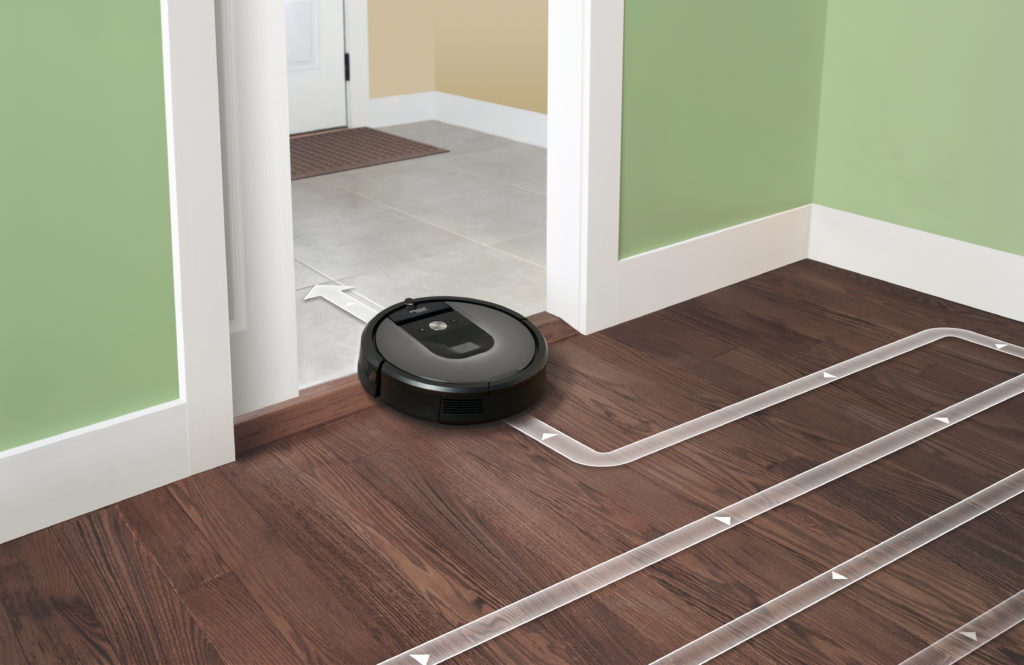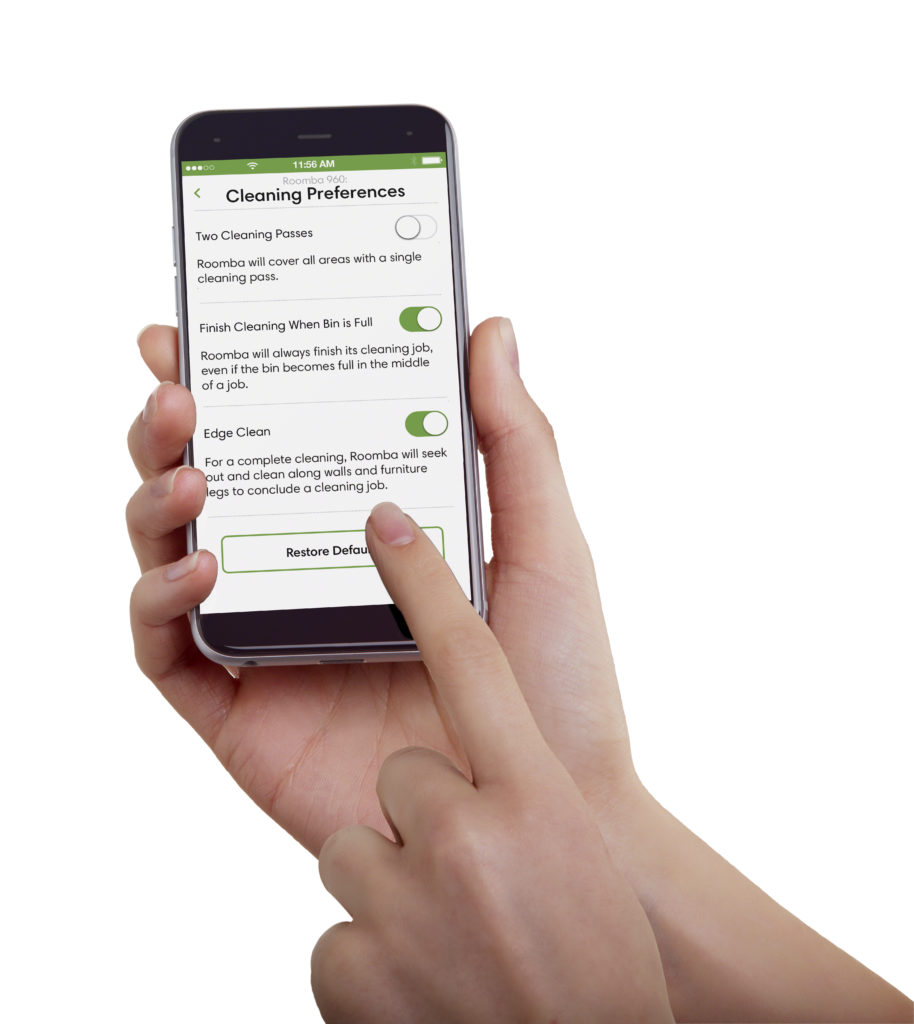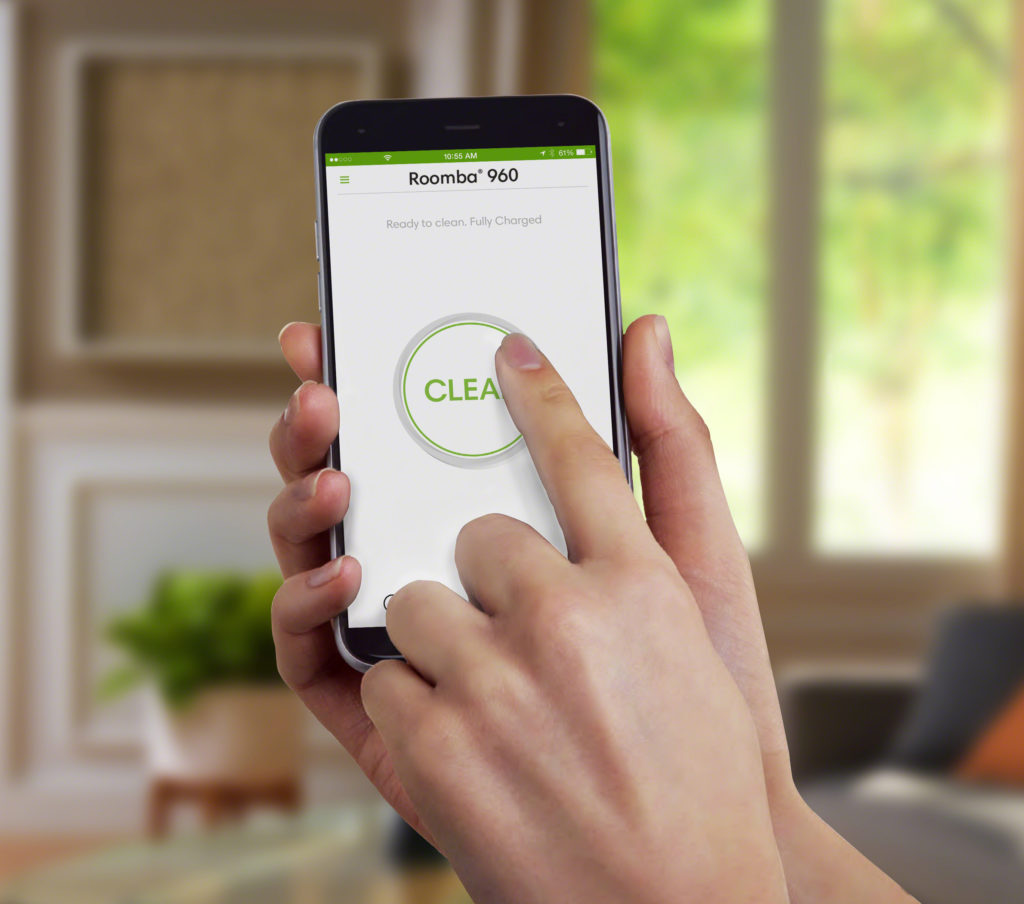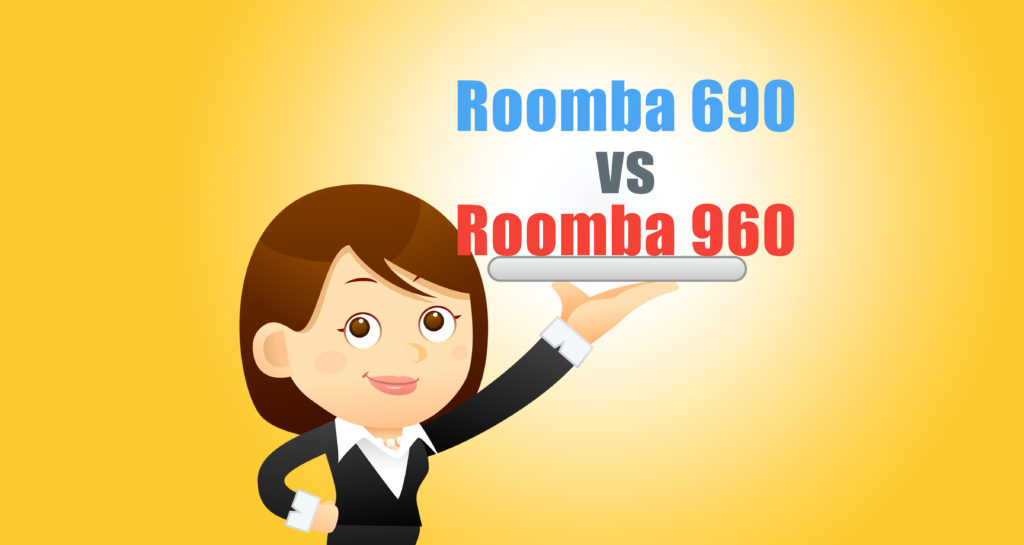When it comes to maintaining the floor cleanliness of your home, more people are turning to robotic vacuums. Why not? Any means to help clean the floors with robotic automation is a good thing.
Everyone wants to feel a little more like the Jetson’s and have Rosie come out and vacuum up the daily spills and messes. iRobot allows this to happen with the Roomba robotic vacuums. Today we will look at two of their more popular models: the 690 and the 960.
If you want to know all the details about each of these models, read the article below. If you are just looking for the brass tacks to know which one you need: We have selected the Roomba 960 as the better option overall. The 690 is a great vacuum for those who are looking for an entry level robot vacuum.
Contents
What’s Different between the Roomba 690 and 960?
From looking at the machines, you may not be able to see too many differences. However, there are quite a few. Here’s the rundown of the major differences:
- The 690 uses the three-stage cleaning AeroVac technology while the 960 uses the newer, more advanced AeroForce technology.
- The 690 model has a micro-filtration AeroVac filter. The 960 uses the anti-allergen HEPA filtration.
- The 690 makes use of counter-rotating bristle extractors. The 960 has brush-less rollers.
- The 690 will not resume cleaning after a recharge unless manually told to do so. On the other hand, the 960 will recharge and automatically resume cleaning where it left off.
- The 690 does not have a full bin indicator and must be checked regularly. The 960 will alert you when the collection bin is full.
- While the 690 does have side brushes to clean edges and corners, the 960 has Edge Cleaning mode that will concentrate on the hard to reach edges separately.
- The 690 makes use of the original iAdapt sensor technology for mapping and navigation. The 960 uses the more advanced iAdapt 2.0 technology.
- The 960 has a top mount camera for mapping and navigation. The 690 does not.
What About The Similarities between them?
There are similarities between the two models that are worth noting. Similarities will help you decide which of the features you can live without to further narrow down your choice before purchase.
- Both models have WiFi connectivity which allows you to use the iHome app to control the vacuum.
- Both come with the Lithium-Ion rechargeable battery packs.
- The 960 and the 690 both allow for scheduling to automatically clean at any point in the future.
- Both robot vacuums will sense when their batteries are low on charge and return to the dock on their own.
- Both of the Roomba vacuums utilize spot cleaning mode using the iHome app on your cell phone.
- Each of the robot vacuums can link to smart home devices such as Amazon Alexa and Google Assistant for voice command control.
- Both models come with the Virtual Wall Barriers for area control.
Let’s Take A Side By Side Look
The comparison table below will show you the features and options side by side so you can quickly see which model has the features you are looking for.
| Roomba 690 | Roomba 960 | |
| Navigation Technology | iAdapt | iAdapt 2.0 |
| Vacuum Technology | AeroVac | AeroForce |
| Battery | Lithium-Ion | Lithium-Ion |
| Filter | AeroVac | HEPA |
| Carpet Boost | No | No |
| Edge Cleaning Mode | No | Yes |
| Full Bin Indicator | No | Yes |
| Built-In Camera | No | Yes |
| Spot Cleaning | Yes | Yes |
| Voice Control (Alexa) | Yes | Yes |
| Remote Control | iHome App | iHome App |
| Entire Level Cleaning | No | Yes |
| Multiple Cleaning Passes | No | Yes |
| Virtual Wall Barriers | 2 | 2 |
| Price | Check on Amazon | Check on Amazon |
Options and Features
We will now take a closer look at the features and options for the two vacuums. You may decide that certain features you can do without or perhaps you will see one that you just have to have. Hopefully, it will help you make a more informed decision.
iRobot made a giant leap in their navigation and mapping technology with the iAdapt 2.0. The new technology allows for better mapping of the area and navigation around obstacles while cleaning.
The original technology works well, but the navigation was lacking. The robots will navigate the entire space but in a seemingly random manner. With the iAdapt 2.0, the navigation is more “human-like” using straighter lines and a more thorough coverage.
Bottom Line: The 960 has the edge on navigation because of the iAdapt 2.0 technology.
2. Filter Types
Microfiltration has always been a benchmark of Roomba vacuums. The 690 model uses AreoVac filtration that allows for small particle collection in an AreoVac filter.
The 960 takes it one step further and uses HEPA filtration that will collect 99 percent of dust and allergens in the home. This is a better option for homes with pets or allergies.
Bottom Line: The HEPA filtration found in the 960 is far superior to the AreoVac filtration of the 690.
3. Multiple Cleaning Passes
A new feature to the 960 model robots is Multiple Pass Control (MPC). You can force the vacuum to go over the area (entire or specific) a second time to get a more thorough clean.
This is helpful if you have multiple pets or pets that shed a lot, small children who make excessive messes in the dining room, or even high traffic areas that may need a second pass. With Multiple Pass Control, these areas get a more concentrated pass for a deeper cleaning.
You have the option to set the pass control which defaults to automatic. Automatic gives the pass control to the robot and its sensors. Using the iHome app you can toggle the Cleaning Pass Controls Options.
Bottom Line: The 960 has the clear advantage with the ability to do multiple passes. The battery life isn’t much of a concern with the auto-recharge capabilities but is something to think about.

4. Edge Cleaning Mode
Another new technology that the Roomba 690 does not have is Edge Cleaning mode. While the 690 does have side brushes and will get to the edge and corners, the 960 takes it one step further: allowing you to specify that the edges need more attention.
By utilizing this feature, the vacuum will run along the edges of the mapped area and use the side brushes to push dirt and debris away from the edge for a more thorough cleaning. The drawback is that the robot will run slower while doing this, which will diminish the battery life.
Bottom Line: The Edge Cleaning mode of the 960 makes tough to reach areas easier to maintain.

5. Built-In Camera
The Roomba 960 has a built-in camera that utilizes VSLAM technology to increase the mapping and navigation abilities of the robot. Using the camera while mapping the Roomba 960 can better gauge the layout of the area and make a more precise map.
While cleaning, the robot will use the camera to notice obstacles that it can’t pass under to avoid contact or damage.
The Roomba 690 does not have the vSlam software or a built-in camera and will rely only on the acoustic and physical sensors using the iAdapt technology.
Bottom Line: The built-in camera is a huge advantage in mapping and navigation, and the 960 is the better vacuum because of it.
6. Spot Cleaning
One great advancement that came with the iHome app control was the ability for spot cleaning. With spot cleaning, you can direct the Roomba robot to a specific area for a deeper clean.
When activated, the robot will come to the spot and make several circular passes in a three-foot diameter around the area. The sensors will alert the robot when the area is clean, and it will then resume its normal cleaning cycle from where it left off.
Bottom Line: Spot cleaning is a great feature offered by both models that allow for a deeper clean in a high traffic area or a quick clean when the baby drops his cereal.
7. iHome App Control
The Wireless ability for the robotic vacuums to connect to your home network allowing you to take full control of the Roomba from your smartphone.
The iHome app allows you to schedule cleanings, start or force dock the vacuum, utilize the spot clean functionality of the vacuum, and even name your robot.
You can even start, schedule or stop a cleaning when you aren’t home. Using the app on your smartphone means you can take full control no matter where you are.
Bottom Line: Plans change, and the ability to have your robot vacuum clean your floors before you get off work is one less thing to worry about when your boss surprises you by coming for dinner after work. Both models support the iHome App.

8. Entire Level Cleaning
Both the Roomba 690 and the Roomba 960 will clean the entire area you specify or schedule. However, only the 960 model offers “entire level cleaning.”
What this means is that when the cleaning has started, and the robot needs to recharge the batteries, the 960 will return to the dock and recharge. Once the batteries have been charged the 960 will automatically leave the dock and return to where it left off to finish the job.
The 690 will also return to the dock when it’s battery power is low to recharge. However, it will not automatically resume the cleaning until you manually tell it too either using the iHome app or the clean button on the machine itself.
Bottom Line: The ability for the 960 to resume its cleaning cycle without being told like some ten year old with chores, makes it a clear winner with this feature.
9. Smart Home Integration
Each of the models uses WiFi to connect to the iHome app and many smart home technologies that make use of the wireless network in your home.
Amazon Alexa and Google Assistant, for example, will allow you to use voice commands to control your Roomba vacuum. This is a huge convenience for when you need a spot clean or quick run through while your hands are full with dinner or the kids.
Bottom Line: Voice control is a giant step in complete home automation. Both robots have this capability.
10. Extractors
The Roomba 690 uses counter-rotating bristle extractors to loosen the dirt and debris for removal. These are similar to the standard rotating bars on upright vacuums, and they come with the same drawbacks. Hair and threads easily get tangled on the extractors and need to be cleaned off regularly.
With the Roomba 960, you have brush-less extractors that don’t get easily tangled with long hair and threads. You will, of course, get some wraps as that is the nature of all vacuums. However, maintenance is easier because you don’t need to untangle hair and string from the brushes.
Bottom Line: The 960 gets the win because of the ease of maintenance and the fewer instances of even needing it. The 690 will need to be inspected and cleaned a lot more often.
What to Like About the Roomba 690
Without a doubt, the Roomba 690 is a well-equipped robotic vacuum. It has several features we absolutely love:
- Lithium-Ion batteries are a huge advantage over the Nickle Metal Hydride type.
- Automatic recharging and docking mean you don’t have to worry about finding your vacuum dead in the middle of the floor.
- The Virtual Wall Barriers help keep the robot in it’s designated area and away from potted plants, pet dishes and other items you want to be protected from damage.
- The iHome app makes wireless control of your vacuum possible.
- Spot cleaning is a great feature that becomes more and more useful over time.
- Cost versus features is an excellent ratio for those on a budget.
What to Like About the Roomba 960
Not to be outdone, the Roomba 960 is packed with features that seem more essential than optional:
- HEPA filtration is crucial for homes with pets and allergies.
- The built-in camera and VSLAM software make mapping and navigation better than any other option.
- Entire level cleaning allows you to rest assured your entire area will be cleaned, even if the robot has to recharge.
- Brush-less extractors mean less maintenance and more free time.
- IAdapt 2.0 software enhances the sensors and the vacuums ability to map and navigate your home.
The Conclusion
When it comes down to a decision, you have to weigh cost over features. The Roomba 960 has a lot of added features that just aren’t available on the 690 model.
If you need total control and complete worry-free cleaning of your floors, the Roomba 960 is going to meet your needs. You will pay more for the features versus the 690, but in the end, the extra money spent will be worth it.
If you are on a tighter budget and want a reliable clean with some of the more advanced options now available, the Roomba 690 might be the choice for you. You will get a great clean throughout your home, and if you don’t need the extra features, you can save a lot of money.
Our choice for the better robotic vacuum is the Roomba 960. It does cost a bit more than the Roomba 690, but we feel the added features are well worth the cost in this instance.
Click here for all the robot vacuum deals on Amazon today.

Thanks for the info and details. I am glad I found this site.
I am torn between the two models. I have a home with 80% tile and engineered hardwood floor with no pets or kids. It is about 2400 square feet with only a master bedroom with carpet with 3 area rugs. Am I gaining much with going with the higher 960c model especially with the amazon sale you mentioned today? Or go with 690 and just buy an extra charger?
Hey Twala,
The 960 has several improvements over the 690, the most salient improvement, one that I notice in daily use, is the brushless rollers. It saves time not having to pull hair out of the rolling brushes. If no one in your family has long hair, stuck hair might not be a problem.
Some other improvements of the 960 are recharge and resume, vacuuming in straight lines, and a HEPA filter.
The choice is definitely not easy, but I think either one will work. There is no need to buy an extra charger.